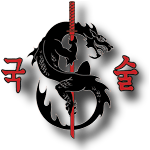The romantic origins of Kuk Sool date back to the very beginning of Korea,
starting with “Sah Doh Mu Sool”
which means family or tribal martial art. The next martial art
to develop was “Koong Joong Mu Sool,” or “Royal
Court Martial Art.” Shortly afterwards came “Bull
Gyo Mu Sool,” which refers to the martial arts
practiced in the Buddhist temples during ancient times.
These are the three segments of Korean martial arts
history from which the techniques of Kuk Sool are said to be derived.

So it can be said that Kuk Sool is an extensive martial arts
system which is derived from the rich and varied martial
art techniques and traditions that have arisen in Korea
throughout the ages. Realize that Kuk Sool is not considered a sport, nor is
it simply another oriental self defense method, rather it
is a comprehensive martial art that is dedicated to
the cultivation of mental and physical well-being and
to the preservation of traditional Korean Martial Arts.
Kuk Sool is recognized as an extensive martial arts system which is based on the rich and varied martial
art techniques and traditions that have arisen in Korea throughout the ages. Technically, Kuk Sool is not
considered a sport nor is it simply another oriental self defense method, rather it is a comprehensive
martial art that is dedicated to the cultivation of mental and physical well-being and to the preservation
of traditional Korean Martial Arts.
For self defense, Kuk Sool is unsurpassed. It combines
kicking, punching, throwing, falling, choking, joint-locking
and a myriad of weapons techniques into a beautiful
and dynamic style that emphasizes speed and fluidity.
In conjunction with the physical training, the study of acupressure/acupuncture points
as well as practicing certain breathing techniques
& meditation, is
employed to improve and maintain health, to develop internal
power, and to lessen the effects of aging.
Philosophically, Kuk Sool stresses humility, self
discipline, loyalty and respect for others. Together,
all of these aspects allow Kuk Sool to provide the
means for attaining a long and healthy life.
As a martial arts system, Kuk Sool covers
the full spectrum of Asian fighting
methods and body conditioning secrets, as well as emphasizing mental
development and traditional weapons training. Below is a sampling of what Kuk Sool has to offer:

